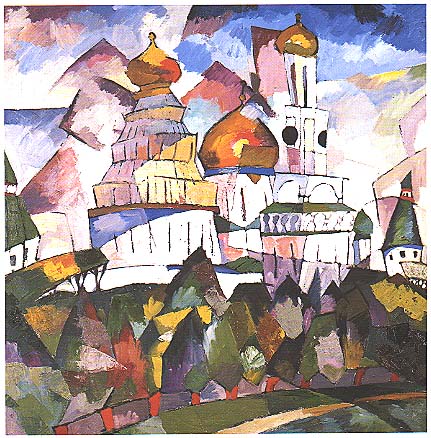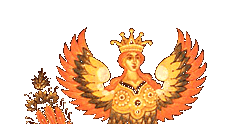 LENTULOV, Aristarkh Vasilyevich was born in 1882, Voronye village, near Penza; died 1943, Moscow.
Studied in art schools in Penza (1898-1900, 1905-06) and Kiev (1901-05), in the private studio of Dmitry Kardovsky in St. Petersburg (1906) and at the Academie de la Palette in Paris (1911).
Member of the Knave of Diamonds (from 1911) and the World of Art (from 1917), participant in exhibitions from 1906: Wreath (1908), Link (1908), Wreath-Stefanos (1909), Salons of Vladimir Izdebsky (1909-10), Knave of Diamonds (1910-14, 1916, 1927), World of Art (1911-12, 1917-22), AKhRR (1926, 1928), Society of Moscow Artists (1928-29) etc.
Lived in Moscow, from 1915 working for Moscow theaters. From 1919 taught at the Svomas and VKhUTEMAS.
In a parody-like self portrait A. Lentulov depicted himself as a party Bogatyr (1913), which in general confirmed to his lifestyle. One of organizers of the Jack of Diamonds union (1910), he represented the "naive" and "nationalistic" wing of the art organization. He was also very consistent in cubofuturism.
Lentulov was considered very left wing even during his years of study. Under D.N. Kardovskiy he began displaying his art at various exhibitions: "Stefanos" (1907), "Garland" (1908). (He also studied in the Penza and Kiev art schools: 1898-1905)
Later, during the "diamonds" period, his leftism gained a system. While studying in Paris under A. Le Fokonie, the artist became acquainted with the theoretics of cubism: A.Glesome and J. Metsenge. Their method of painting was incorporated by the young artist to his natural fascination with open, somewhat lyubok-like colors, to large painting format and to the "noise" of art in general.
Paintings by Lentulov of this period are composed of dynamically colliding, loudly colored planes - dimension gravitates towards the plane, flat planes are decorated with designs and applied stickers. Example - the urban landscape of Moscow ("Saint Basils" (1913), "Bell Toll" (1915), "At the Iverskaya" (1916), "Moscow (1916) - all look like not-man-made blooming "architectural miracle".
In the early 1920s Lentulov leaves large scale painting for smaller sized ones, and more naturalistic. He became the leader of Society of Moscow Artists in 1928 (uniting the former "diamonds" participants). His art becomes more tonal, somewhat keeping the principals of fortified colors. He creates landscapes, portraits, still-lifes penetrated with a feeling of fullness of life: ("Dawn at Volga" (1928), "Sun over the Roofs. Sunrise" (1928), "Vegetables" (1933) and etc.)
Lentulov now, mostly works for theater decorations, the theater-dweller-artist bravo-optimistic lifestyle appealing to his character very much.
He co-produced with A.Y.Tairov, F.F. Komissarjevskiy and V.I. Nemirovich-Danchenko. His most famous theatrical decoration was for a drama "Spanish Priest" (1934 by F. Bomonta and G. Fletcher) at the MHaT theater in Moscow.
Lentulov taught art at VhuTMAs (since 1919) and in Moscow Art Institute from 1937 - 1943.
LENTULOV, Aristarkh Vasilyevich was born in 1882, Voronye village, near Penza; died 1943, Moscow.
Studied in art schools in Penza (1898-1900, 1905-06) and Kiev (1901-05), in the private studio of Dmitry Kardovsky in St. Petersburg (1906) and at the Academie de la Palette in Paris (1911).
Member of the Knave of Diamonds (from 1911) and the World of Art (from 1917), participant in exhibitions from 1906: Wreath (1908), Link (1908), Wreath-Stefanos (1909), Salons of Vladimir Izdebsky (1909-10), Knave of Diamonds (1910-14, 1916, 1927), World of Art (1911-12, 1917-22), AKhRR (1926, 1928), Society of Moscow Artists (1928-29) etc.
Lived in Moscow, from 1915 working for Moscow theaters. From 1919 taught at the Svomas and VKhUTEMAS.
In a parody-like self portrait A. Lentulov depicted himself as a party Bogatyr (1913), which in general confirmed to his lifestyle. One of organizers of the Jack of Diamonds union (1910), he represented the "naive" and "nationalistic" wing of the art organization. He was also very consistent in cubofuturism.
Lentulov was considered very left wing even during his years of study. Under D.N. Kardovskiy he began displaying his art at various exhibitions: "Stefanos" (1907), "Garland" (1908). (He also studied in the Penza and Kiev art schools: 1898-1905)
Later, during the "diamonds" period, his leftism gained a system. While studying in Paris under A. Le Fokonie, the artist became acquainted with the theoretics of cubism: A.Glesome and J. Metsenge. Their method of painting was incorporated by the young artist to his natural fascination with open, somewhat lyubok-like colors, to large painting format and to the "noise" of art in general.
Paintings by Lentulov of this period are composed of dynamically colliding, loudly colored planes - dimension gravitates towards the plane, flat planes are decorated with designs and applied stickers. Example - the urban landscape of Moscow ("Saint Basils" (1913), "Bell Toll" (1915), "At the Iverskaya" (1916), "Moscow (1916) - all look like not-man-made blooming "architectural miracle".
In the early 1920s Lentulov leaves large scale painting for smaller sized ones, and more naturalistic. He became the leader of Society of Moscow Artists in 1928 (uniting the former "diamonds" participants). His art becomes more tonal, somewhat keeping the principals of fortified colors. He creates landscapes, portraits, still-lifes penetrated with a feeling of fullness of life: ("Dawn at Volga" (1928), "Sun over the Roofs. Sunrise" (1928), "Vegetables" (1933) and etc.)
Lentulov now, mostly works for theater decorations, the theater-dweller-artist bravo-optimistic lifestyle appealing to his character very much.
He co-produced with A.Y.Tairov, F.F. Komissarjevskiy and V.I. Nemirovich-Danchenko. His most famous theatrical decoration was for a drama "Spanish Priest" (1934 by F. Bomonta and G. Fletcher) at the MHaT theater in Moscow.
Lentulov taught art at VhuTMAs (since 1919) and in Moscow Art Institute from 1937 - 1943.
 Churches. New Jerusalem (1917)
Reference: http://www.msi-mall.com/art/avantgarde/artists/lentulov.html
Churches. New Jerusalem (1917)
Reference: http://www.msi-mall.com/art/avantgarde/artists/lentulov.html
|



